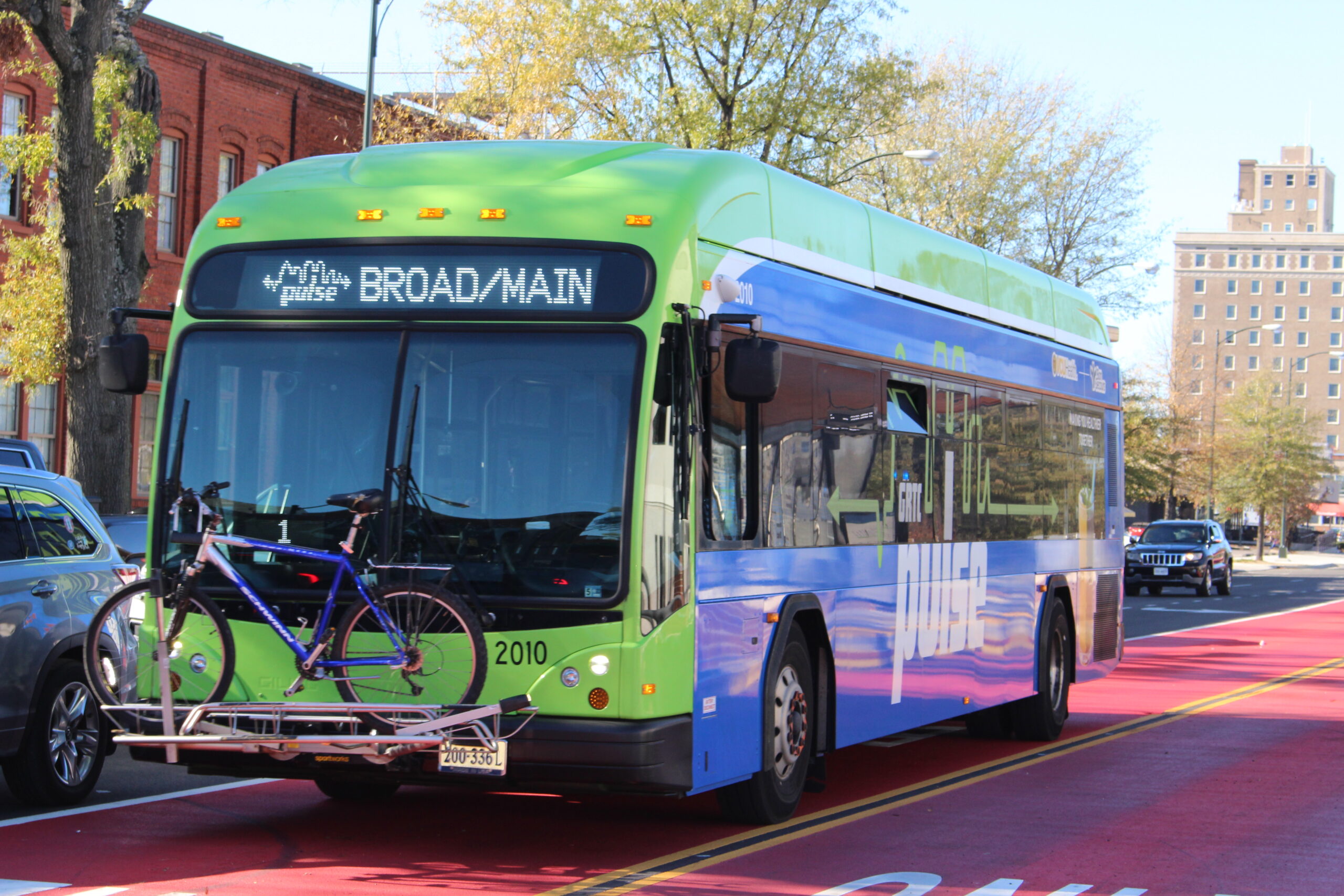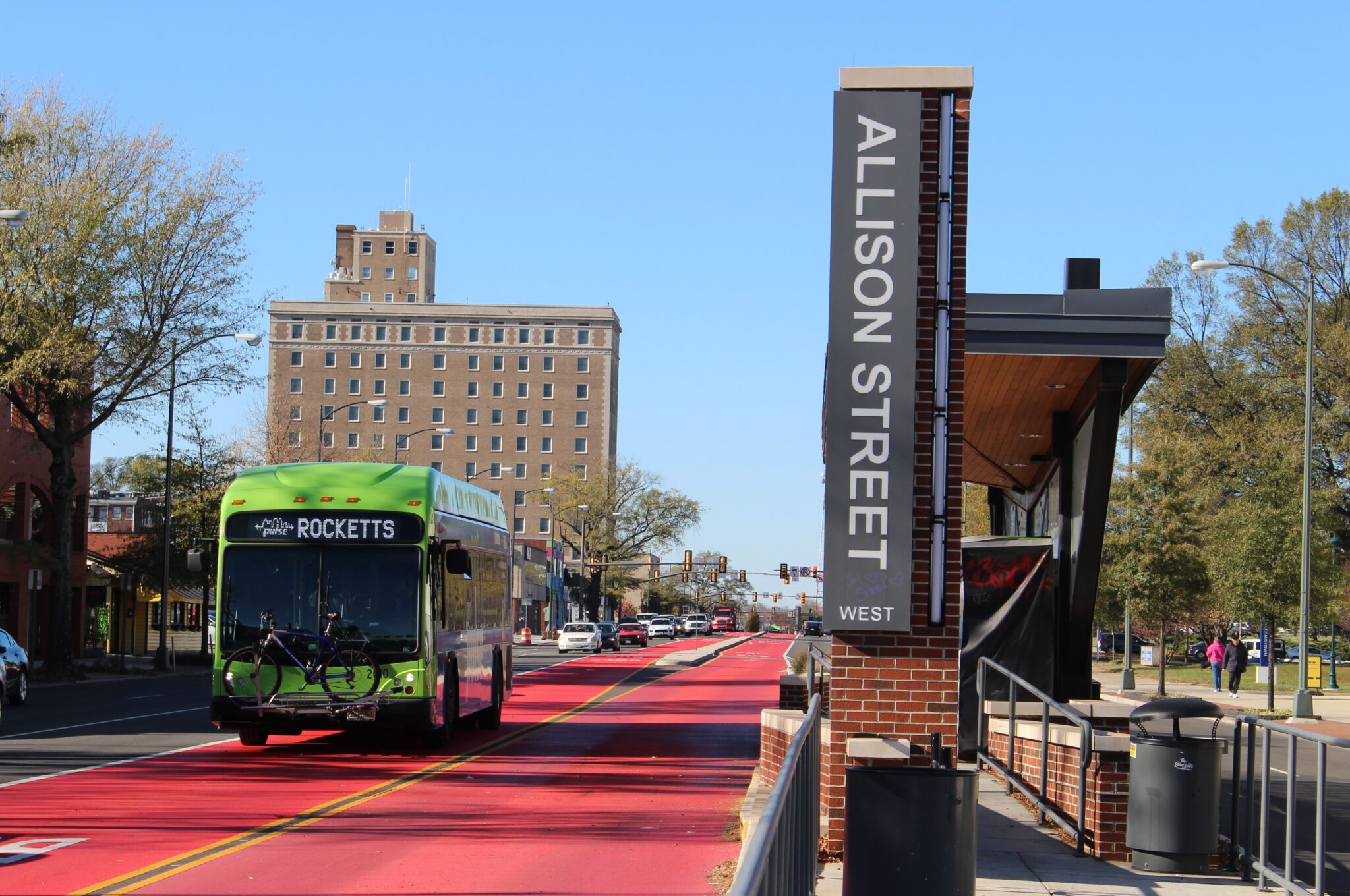Editor's note: this article originally appeared on Virginia Mercury and is republished with permission.
Since it began operating in June 2018, Richmond’s Pulse has driven its way to becoming one of the most successful bus rapid transit services in the country.
Now transportation leaders from as far away as Ohio, Maryland and Florida are taking notice as they consider jumping on board with similar systems in other densely populated areas.
Sam Sink, director of planning and scheduling for the Greater Richmond Transit Company, which operates the Pulse in Virginia’s capital city, said passengers are turning to rapid transit services due to their frequent stops and reliability compared to buses.
Bus rapid transit “really thrives in these denser, more urban corridors where a lot of people are trying to travel at the same time,” Sink said. “It provides reliability that maybe local bus service can’t always achieve.”
A success story
The Pulse, which runs along a 7.6-mile route from Rocketts Landing in Richmond to Willow Lawn in Henrico County, has exceeded ridership expectations since its launch.
In May 2019, GRTC reported that ridership across its whole system had increased by 17% over the past year, “countering the national trend of transit ridership decline.” The agency highlighted the Pulse as a particular success: The system’s busiest bus route, it noted, “now carries an average of more than 7,000 riders every weekday, double the service’s goals.”
By June 2021, the Pulse had carried almost 5 million passengers, with a spokesperson telling WTVR the line had “far exceeded even our hopes and expectations.”
Bus rapid transit differs from other bus service in that it relies on dedicated lanes, traffic-signal priority and elevated platforms, all of which allow it to be more efficient and reliable compared to riding a local bus that must share lanes with other traffic.
The service put Richmond on the map as having one of 10 verified rapid transit corridors in the United States. And in 2019, the Pulse earned a bronze rating by the Institute for Transportation and Development Policy, a nonprofit organization that focuses on developing bus rapid transit systems, for its “high-quality bus-based transit system that delivers fast, comfortable, and cost-effective services that replace less competitive local services.”
So successful has the line been that GRTC officials are considering expanding the Pulse, with plans to identify the next potential segment by early next fall.
Growing interest in bus rapid transit
Last month, the Pinellas Suncoast Transit Authority launched its first bus rapid transit system, SunRunner, which runs 10 miles from downtown Petersburg to St. Pete Beach in Tampa, Florida. The corridor includes about 40,000 residents and 50,000 employees.
But before officials began operations, they came to Richmond to get some insight from GRTC on the Pulse.
Abhishek Dayal, director of the authority’s project management office, said the Florida agency decided to follow Richmond’s lead in having ambassadors available when the bus service first launched to guide future passengers. While his agency does not release ridership data, he said there has been a lot of interest in the new transit service.
“We’ve seen tremendous response already from a lot of people, many of whom have never ridden public transportation before,” Dayal said.
The Southwest Ohio Regional Transit Authority also reached out to GRTC for guidance on design, community engagement and funding as it developed its own bus rapid transit service.
“The group was very impressed with the [agency’s] service design model, which included the design of their bus only lanes and center street switchouts, in addition to the economic development impacts evident along the service lines,” authority spokesperson Brandy Jones wrote in an email. “The team was also very impressed regarding the considerable efforts the agency deployed to ensure the safety and security of its system.”

The future of BRT in Virginia
Scudder Wagg, a transportation consultant, said one reason for planners’ heavy interest in developing rapid transit services is their cost effectiveness.
“The experience of building big rail projects in a lot of communities in the last 30 to 40 years has been that it’s extremely expensive on a per mile basis,” said Wagg. “And so if you’ve got a major corridor where you want to improve transit service, BRT can be done for generally much less cost per mile, that you’re building on a corridor.”
Virginia is already home to the Metroway BRT in Alexandria and Arlington County, and multiple other localities are considering bus rapid transit systems, including Charlottesville, Norfolk and parts of Northern Virginia.
Charlottesville leaders are in the early stages of considering the most suitable place to create a transit corridor. Wagg said some possibilities include the U.S. 29 corridor from Albemarle through Barracks Road and a route on the northern part of the city near the University of Virginia and downtown.
In Norfolk, officials are mulling whether to add light rail or bus rapid transit to connect the existing Tide light rail system with Naval Station Norfolk.
And Northern Virginia officials said they are at least two years away from operating an upgraded bus rapid transit system on Route 7. The 14-mile corridor is one of the region’s busiest, connecting Fairfax and Arlington counties and Falls Church and Alexandria.
An overwhelming number of respondents to a survey conducted by the Northern Virginia Transportation Commission agreed that improved transit service is necessary along the corridor, which includes job centers and access to two Metrorail stations.
Projections show that population and job growth in the area will increase 35% by 2040, according to officials from the commission, which is heading up the Envision Route 7 project.
“I think that effort is out there to make sure that there’s really good transit service and how’s the best way we can do it in an affordable and more financially reasonable way,” said Allan Fye, director of programs and policy at NVTC.
Alexandria is also planning the West End Transitway BRT, while Fairfax is developing the Richmond Highway BRT along Route 1.
Xavier Harmony, a senior program manager for the commission who recently toured the Pulse system, said a major takeaway from his visit was the Pulse’s ability to increase bus speed by 65%.
That change can be “hugely impactful for people,” he said.
“[If] you can increase it by even 50%, you can have huge benefits to travel time savings for people who use the system,” Harmony said. “You also can have a safe operating environment.”






